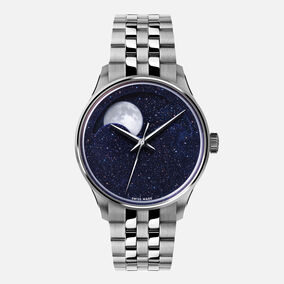As found on the C1 Moonphase and C63 Celest, when it comes to dial materials, aventurine is a glass that’s perfect for our dressiest watches
If you’re a Christopher Ward fan, you’ll have noticed that two of our recent watches, the C1 Moonphase and C63 Celest – feature a sparkling ‘aventurine’ glass dial. But what is aventurine? And why have we started using it on our watches? Here’s what you need to know.
What is aventurine?
Aventurine (‘Avventurina’ in Italian) is a type of glass invented on the Venetian island of Murano in the 17th century – ‘all’avventura’ means ‘adventure’ or ‘chance’. According to legend, it came about when a glassmaker accidentally dropped metal shavings into molten glass, giving the glass an ever-changing shimmer.
How is it made?
Christopher Ward’s Head of Product, Jörg Bader, says: “Aventurine is produced by mixing transparent deep-red ‘ruby glass’ and a brown-red ‘purpurin glass’. Then, shavings of metal oxide – like cobalt – are added. However, here we substitute cobalt for copper, which turns the glass a shade of what we call ‘Galaxy Blue’. A shade that’s perfect for luxury watches because it contrasts with the handset while maintaining the sparkling appearance of the glass.”

“Only the most careful watchmakers can be trusted with an aventurine dial”
Isn’t there a mineral called ‘aventurine’?
Yes, it’s a type of quartz that was discovered in the 18th century. Because of the way it shimmers, it was named ‘aventurine’ after the glass. Not the other way around.
Aventurine watches are comparatively rare. Why’s that?
“Aventurine is incredibly fragile,” says Jörg Bader Jnr. “So when you push it too hard, it breaks. Indeed, only the most careful watchmakers can be trusted with an aventurine dial.”
How is aventurine used on the C1 Moonphase?
“Most watches using aventurine only give you a single piece, most often the dial,” says CW designer William Brackfield. “But we’ve got such a huge moon aperture that we had to make the rotating disc underneath of aventurine, too. This posed huge challenges – not least that it inevitably adds thickness, as the inner rotating disc, holding the twin luminous ceramic moons (one always hidden out of sight), needs a brass backing to keep it secure.” But when you see it in the finished watch – you know all the hard work has been worth it!”
Related watches

Sign up to Loupe magazine
Loupe is Christopher Ward’s quarterly in-house magazine. If you want to know what’s happening at CW (and you love great journalism), this is where to start. Alternatively, you can read all our back issues on your computer, tablet or phone.
Order your free copyRead Loupe online





